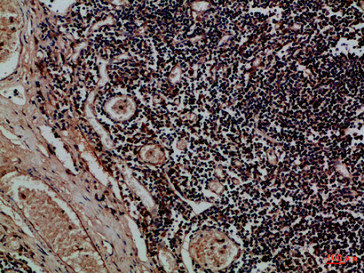![FACS analysis of human peripheral blood using GTX00515 KIR2DL5A antibody [UP-R1]. FACS analysis of human peripheral blood using GTX00515 KIR2DL5A antibody [UP-R1].](https://www.genetex.com/upload/website/prouct_img/normal/GTX00515/GTX00515_20191028_FACS_1_w_23053121_576.webp)
FACS analysis of human peripheral blood using GTX00515 KIR2DL5A antibody [UP-R1].
KIR2DL5A antibody [UP-R1]
GTX00515
ApplicationsFlow Cytometry, ImmunoFluorescence, ImmunoCytoChemistry
Product group Antibodies
TargetKIR2DL5A
Overview
- SupplierGeneTex
- Product NameKIR2DL5A antibody [UP-R1]
- Delivery Days Customer9
- ApplicationsFlow Cytometry, ImmunoFluorescence, ImmunoCytoChemistry
- CertificationResearch Use Only
- ClonalityMonoclonal
- Clone IDUP-R1
- Concentration1 mg/ml
- ConjugateUnconjugated
- Gene ID57292
- Target nameKIR2DL5A
- Target descriptionkiller cell immunoglobulin like receptor, two Ig domains and long cytoplasmic tail 5A
- Target synonymsCD158F, KIR2DL5, KIR2DL5.1, KIR2DL5.3, killer cell immunoglobulin-like receptor 2DL5A, killer cell immunoglobulin-like receptor KIR2DL5A, killer cell immunoglobulin-like receptor, two domains, long cytoplasmic tail, 5, killer cell immunoglobulin-like receptor, two domains, long cytoplasmic tail, 5A
- HostMouse
- IsotypeIgG1
- Protein IDQ8N109
- Protein NameKiller cell immunoglobulin-like receptor 2DL5A
- Scientific DescriptionKiller cell immunoglobulin-like receptors (KIRs) are transmembrane glycoproteins expressed by natural killer cells and subsets of T cells. The KIR genes are polymorphic and highly homologous and they are found in a cluster on chromosome 19q13.4 within the 1 Mb leukocyte receptor complex (LRC). The gene content of the KIR gene cluster varies among haplotypes, although several framework genes are found in all haplotypes (KIR3DL3, KIR3DP1, KIR3DL4, KIR3DL2). The KIR proteins are classified by the number of extracellular immunoglobulin domains (2D or 3D) and by whether they have a long (L) or short (S) cytoplasmic domain. KIR proteins with the long cytoplasmic domain transduce inhibitory signals upon ligand binding via an immune tyrosine-based inhibitory motif (ITIM), while KIR proteins with the short cytoplasmic domain lack the ITIM motif and instead associate with the TYRO protein tyrosine kinase binding protein to transduce activating signals. The ligands for several KIR proteins are subsets of HLA class I molecules; thus, KIR proteins are thought to play an important role in regulation of the immune response. [provided by RefSeq, Jul 2008]
- Storage Instruction2°C to 8°C
- UNSPSC12352203



